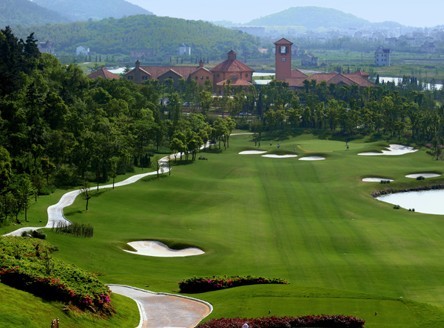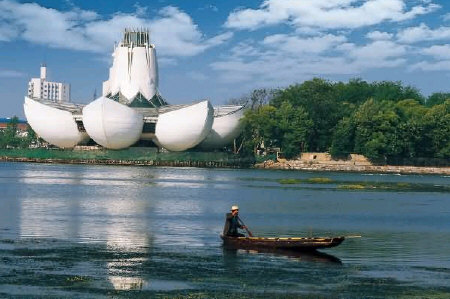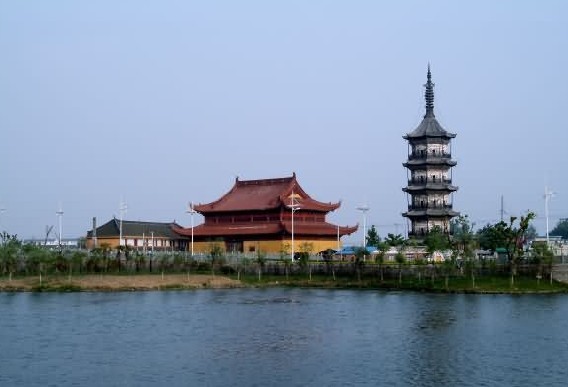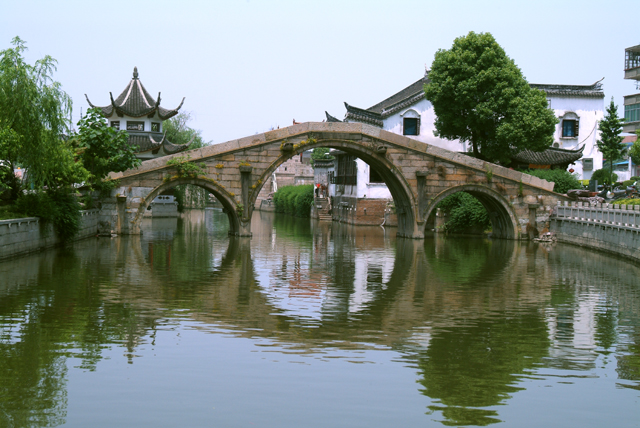Jiulongshan Holiday Resort
Covering an area of 9.46 km2 and incorporating various tourism resources such as mountains,sea,islands and beaches,it is the most special seaside recreational area in north Zhejiang Province.In 1998 its approved as a provincial level holiday resort by the provincial government.With its favorable natural resources and drawing the concepts and techniques from an international design master,this area will develop into a magnificent holiday resort that delivers both European and Asian flavor as it combines European culture elements with the unique mountainous and sea sceneries.
By now a group of brand high-class tourism products in the resort have been established,including the golf club,yacht club and polo club,holiday apartments,Westin Hotel and Daoshan Buddhism Culture.Currently the resort is busy optimizing its development plan,introducing and utilizing supplementary faculties and services for the resort.The concerned parties aim to create a top seaside holiday resort that caters both the high class and general public.
The west part of the resort is a state-level forest park which situates historical sites such as Nanwan Cannon Emplacement and Tianfei Palace Cannon Emplacement in memory of invasion-resisting wars in history,Haihong Pavilion memorizing a scene in the book Hong Lou Meng(A Dream of The Red Mansion)and the Wentao Pavilion commemorating Li Shutong,also known as Master Hongyi(religious name).The resort is adjacent to the splendid Cross-Hangzhou Bay Bridge and state A-level opening port Jiaxing port.It will certainly overwhelm tourists for its wonderful sceneries.

Donghu(literally meaning East Lake)Scenic Spot
Donghu(East Lake),formed by the confluence of nine rivers,is situated in the east of Pinghu City.It was known as the Nine-Dragon Port in ancient times because it looks like a picture of Jiulong Xizhu(nice dragons playing with a pearl)when seen from above.Around the lake is beautiful scenery and boundless of places of interests.Natural resources and human talents are also abundant here.East Lake Scenic Spot is an integrated area featuring tourism and leisure,culture and festivals as well as medium/high-end residence.It has finished the construction of a three-ring and three-radiation traffic net,thirty-two bridges,eight scenic spots and a large number of public facilities.Drawing on the Top Ten Scenes in East Lake in ancient times and the modern concept of gardening,the Top Eight Scenes in East Lake are built here,which include:Wuhu Chunse(Spring in East Lake),Jiulong Xizhu(Nine Dragons Playing with a Pearl),Hanzhu Ninghui,Nancun Shudui,Taying Chuihong(the Tower Shadow and the Rainbow),Anshan Xiaocui,Beiyuan Muchang and Xipu Yuzeng.East Lake Scenic Spot was listed as the national AAAA-level tourism spot in 2006.Pinghu City is most beautiful for its water.Thus,the scenic spot is near the water;the buildings stand beside the lake and the people live near the lake.Both the lake scenery and the culture of villages and towns on Yangtze River are highlighted.The scenic spot also has large scale of greenbelt and focuses on the harmony of the whole environment,forming a unique and charming scene integrating the characteristics of villages and towns on Yangtze River with modern feelings.
Mos Manor
As one the six Top Manors in South China,which is renowned for the exquisite traditional style gardens in Suzhou and Hangzhou,Mos Manor also merits visit and appreciation.Its on the list of key cultural relic sites under state protection,a state 4A level tourist attraction and a civilized tourist attraction of Jiaxing.

The three-year construction of Moshi Manor belonging to Mo Fangmei,a business giant in Pinghu,started in the 23rd year of the reign of Emperor Guangxu in Qing Dynasty(1897)and cost one hundred thousand taels of silver.Its large enclosed-structure traditional architecture complex.Occupying an area of 7 mu,the manor has a floor space of 2600 m2 and over 70 rooms small or big.The complete set of buildings,distinctive style and abundant articles unparalleled else where in Southeastern China bring the manor attention from all over the world.Its even titled The Forbidden City in South China
Mos Manor also overwhelmed large number of friends from movie circle with its distinctive artistic charm.Since 1981 more than 1000 movies and teleplays such as Dream s of Red Chamber,Family,Spring and Autumn have been shot here.The former mansion of a rich family is now a top tourist attraction featuring on cultural heritage.
Li Shutong Memorial Museum
Li Shutong Memorial museum located besides the beautiful Donghu Lake(East Lake)covering an area of 16 mu.Its shaped as a lotus of seven petals to symbolize Li Shutongs broad mind and integrality since lotus is endowed with such characters in Chinese culture as in the saying Lotus comes out from crystal-clean water.

The museum is a two-storey buildingThe upper floor consists of seven exhibit room and a ring-shaped exhibiting hall that capable to house about 200 calligraphy or painting artworks.Li Shutong was famed for his multiple talents and achievements.He was outstanding in various fields such as calligrapher,painter,inscription,music,drama,education and poem.Photos and other history materials exhibited in the rooms showcase the unparalleled accomplishment and pursuit of perfection of Li Shutong from different aspects:painting,music,drama,poems,calligraphy and inscription,Buddhism study and social influence.They also illustrated the extraordinary life path of Li Shutong from worldly glamour to Buddhism tranquility
Baoben Buddhism Temple(Pagoda)
Baoben Buddhism Temple(Pagoda),also named Baoben Pagoda Courtyard,locates at Yingwu Island,Danghu,occupying an area of 49 mu.The temple is surrounded by water.Graceful lakes reflecting the pagoda,trees on the island flourishing,this place matches peoples imagination of the Penglai Island in the Heaven.The temple is names after the Baoben Pogada.According to the History Record of Pinghu,in the 44th year of Jiajings Reign in the Ming Dynasty(1563),local resident Mr Lu proposed to establish a Buddhism temple in Yingwu(Literally meaning Parrot)Island to embellish the beautiful local landscape.The Temple was completed four years later and named Baoben(literally meaning payback the nurturers),in order to encourage the spirit of gratitude.Traditional Chinese culture believes nature is the nurturer of plants and animals while emperors is the nurturer of the general public,parents,that of our body and teachers that of our merits.Everything has a nurturer and shall pay it back.

The Pagoda was initially built in the year Guihai of Jiajing Period of Ming Dynasty(1563),but collapsed before its completion.Then it was renovated and finished in the year Bingyin of Jiajing Period of Ming Dynasty(1563).After collapsing again in the year Yihai of Shunzhi Period of Qing Dynasty(1659),it was built the third time in the year Gengzi of Shunzhi Period of Qing Dynasty(1660),but was not finished until the year Wuchen of Kangxi Period of Qing Dynasty(1688).It was renovated several times during Qianlong and Daoguang periods of Qing Dynasty.Now it is a site of historical interest and cultural heritages under the protection of Zhejiang provincial government.
Baoben Pagoda is a brick pagoda of pavilion style with an octagonal shape.It has five floors with a height of 49.14 meter totally and ground floor of 8.18 meter in diameter.The outer wall between each two floors,on which winding corridors were designated for people to walk around,is covered with serrated edges in the shape of water chestnut.One can ascend the top floor through the spiral stone stairs inside the pagoda.Round space between each two floors is separated by arched roves.It is topped with an iron spire.
Along with the completeness of the Pagoda the Baoben temple was established.As a sacred Buddhism resort,since its founding the temple has been supervised by eminent monks throughout the ages and remained a popular place of worship.In the 7th Year of reign by Emperor Wanli during the Ming Dynasty(1570),Wang Ji,a student of Wang Yangming(a famous philosopher of the Ming Dynasty),arrived at the temple to give lectures in the Pagoda courtyard.Wangjis lectures incorporate Wang Yangmings LiangZhi theory(literally meaning intuitive knowledge)with the Zen Buddhism,and attracted numerous scholars.Since then the temple had been a gathering place for scholars and writers.In 1935,Li Shutong,also known as the famous Buddhism Monk Hongyi,referred to Baoben temple and its rich cultural relics while lecturing in Wanshou(literally meaning Longevity)Temple on Amitabha Sutra,a compile of his Buddhism studies.
Pinghu museum
Devoted to the collection,protection,study,education,investigation,Pinghu Museum is a comprehensive museum on topology founded in 1958.The new building of the museum was completed in 1999,covering a total area of 5 mu with a construction area of 4900 square meters.
Pinghu museum has a rich collection 16 sorts and nearly ten thousands pieces of historic relic,such as stone artifacts,pottery,porcelains,copper ware,calligraphy and painting,more than 2000 pieces of which are considered as national precious historic relic.For example,Loudspeaker Shaped Pod with a Circle Foot of Majiabang Culture in the Neolithic Age(6000 years ago),Long Hollow Pieces of Jade with Rectangular Slides,Gilt Brass Buddha Head dated from Tang dynasty,Rhinoceros Horn Cup dated back to Ming Dynasty,all of which are all very valuable.Especially,the collection of latter-day calligraphy and painting such as Hanging Scroll of Running Hand Calligraphy by Wen Zhengming in Ming Dynasty,Hanging Scroll of a Figure Painting by Hua Yan in Qing Dynasty,Hanging Scroll of Landscape Painting by Zhang Daqian in Modern times and the works by the masters of the Haishang Painting School like Wu Cangshuo,Ren Yi from Qing Dynasty.One of Pinghu Museums major features is its quantity and high quality.
The bridge,located in Jiefangxi Road of Danghu Town,is a three-arched bridge crossing above Shi River(also name Hantang River)from north to south.It is 26.3 meters in length,3.35 meters in breadth with a middle arch of 8.6 meters in span and 5.2 meters in height,and the other two side-arches of 4.7 meters in span and 2.75 meters in height.Inscriptions like Number 1 Bridge of Danghu and Rebuilt by Local Residents can be seen on top of the bridges two sides.There are 19 stone steps on both northern and southern side of the bridge,well preserved and without decoration,each of which is 50 centimeters high and 20 centimeters thick.They are completely kept on balusters.Arches were put together abreast in segments.There are four couplets engraved on the four columns of the bridge,praising the beautiful scenery,majestic style and peoples wishes to the bridge.

Ostrich Farm
Ostrich Farm is a national AA-level tourism scenic spot,featuring the elegance of the villages and towns on Yangtze River,the countryside feeling of returning to nature and strong folk customs.The programs open to the tourists include:Liangzhu culture,the exhibition of photo on Majiu culture,the exhibition of traditional farming tools and household items used in villages and town on Yangtze River,performance of ancient farming and other participatory and fun activities.The farm has successfully combined the natural scenery with cultural customs,leisure and entertainment and modern technology.Therefore,it serves as an ideal place for holiday travel.In 2009,Ostrich Farm invested about RMB 10 million yuan for expansion.
Jinlongmen Ecological Leisure Park
Located in Longmeng Village in Guangchen Town of Pinghu City,Jinlongmen Ecological Leisure Park is a modern agriculture and leisure park integrating planting and breeding,entertainment and catering,business conference,accommodation and training,popularization and education of science,field development and exhibition of farming culture.The park,located in the golden belt of Yangtze River Delta,is next to the Hangzhou Bay in the south and adjacent to Shanghai in the north.As the largest ecological agriculture leisure park in north part of Zhejiang Province,it covers an area of 1500 mu,of which 1200 mu is land area while 300 mu is watery area.Jinlongmens philosophy is pay attention to ecology,respect the nature.So it integrates tourism with modern agriculture sightseeing,developing it into an ideal place for city people for vacation.